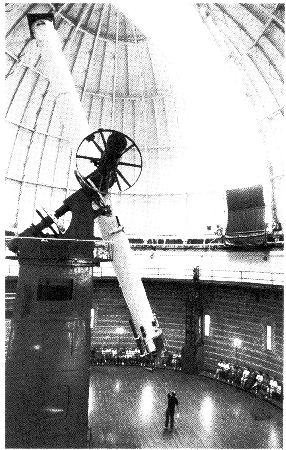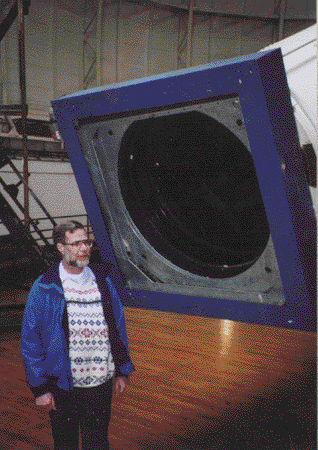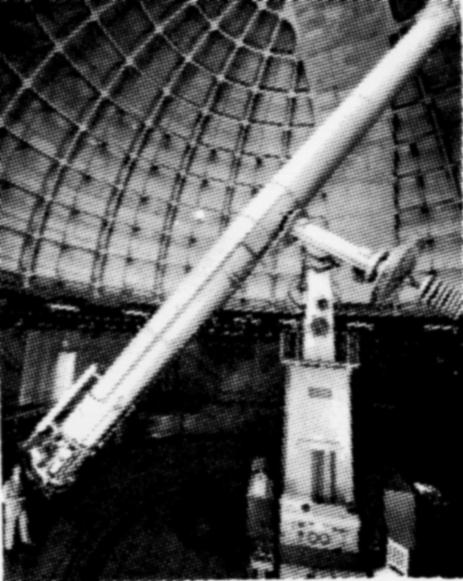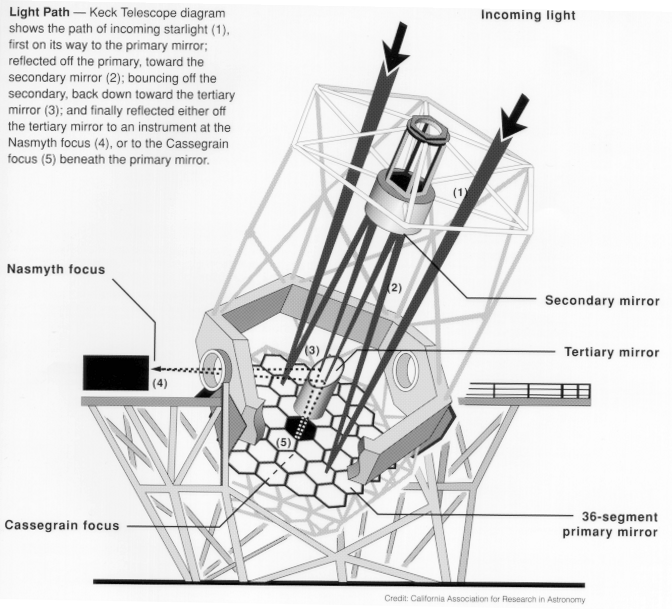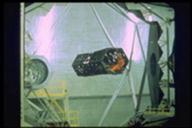Refractor Telescopes
The refractor telescope uses a lens to gather and focus light. The first telescopes built were refractors. The small telescopes sold in department stores are refractors, as well as, those used for rifle scopes.Advantages
- Refractor telescopes are rugged. After the initial alignment, their optical system is more resistant to misalignment than the reflector telescopes.
- The glass surface inside the tube is sealed from the atmosphere so it rarely needs cleaning.
- Since the tube is closed off from the outside, air currents and effects due to changing temperatures are eliminated. This means that the images are steadier and sharper than those from a reflector telescope of the same size.

Though excellent refractors are still made, the disadvantages of the refractor telescope have blocked the construction of very large refractors for use in astronomical research.
Disadvantages
- All refractors suffer from an effect called chromatic
aberration (``color deviation or distortion'') that
produces a rainbow of colors around the image. Because of the wave nature of light,
the longer wavelength light (redder colors) is bent less than the shorter wavelength
light (bluer colors) as it passes through the lens. This is used in prisms to produce
pretty rainbows, but can it ruin an image!

There a couple of ways to reduce chromatic aberration. One way uses multiple compensating lenses to counteract chromatic aberration. The other way uses a very long objective focal length (distance between the focus and the objective) to minimize the effect. This is why the early refracting telescopes were made very long. - How well the light passes through the lens varies with the wavelength of the light. Ultraviolet light does not pass through the lens at all.
- How well the light passes through decreases as the thickness of the lens increases.
- It is difficult to make a glass lens with no imperfections inside the lens and with a perfect curvature on both sides of the lens.
- The objective lens can be supported only at the ends. The glass lens will sag under its own weight.
Reflector Telescopes
The reflector telescope uses a mirror to gather and focus light. All celestial objects (including those in our solar system) are so far away that all of the light rays coming from them reach the Earth as parallel rays. Because the light rays are parallel to each other, the reflector telescope's mirror has a parabolic shape. The parabolic-shaped mirror focusses the parallel lights rays to a single point. All modern research telescopes and large amateur ones are of the reflector type because of its advantages over the refractor telescope.Advantages
- Reflector telescopes do not suffer from chromatic aberration because all wavelengths will reflect off the mirror in the same way.
- Support for the objective mirror is all along the back side so they can be made very BIG!
- Reflector telescopes are cheaper to make than refractors of the same size.
- Because light is reflecting off the objective, rather than passing through it, only one side of the reflector telescope's objective needs to be perfect.

Alas! Despite the advantages of the reflector telescope, astronomers must contend with some minor annoyances.
Disadvantages
- It is easy to get their optics out of alignment.
- A reflector telescope's tube is open to the outside and the optics need frequent cleaning.
- Often a secondary mirror is used to redirect the light into a more convenient viewing spot. The secondary mirror and its supports can produce diffraction effects: bright objects have spikes (the ``christmas star effect'').
The second picture shows the path light travels in the 10-meter Keck Telescope at the W.M. Keck Observatory. The objective is composed of 36 hexagonal mirrors put together to act as one large mirror 10 meters across. Clicking on the image will give you more information about this telescope. The small image next to it shows the 10-meter objective. The person in the red clothing at the center gives you a sense of scale.
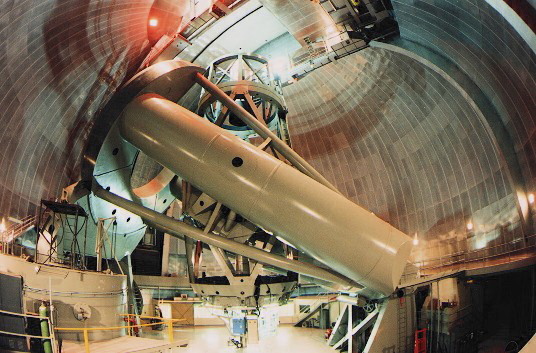
In both the reflector and refractor telescopes, the focus is before the eyepiece, so the image in astronomical telescopes is upside down. Telescopes used to look at things on the Earth's surface use another lens to re-invert the image right-side up. Most reflector telescopes will use a smaller secondary mirror in front of of the large primary mirror to reflect the light to a more convenient viewing spot. Isaac Newton used a flat secondary mirror at a 45ƒ angle to reflect the light to an eyepiece at the side of the telescope tube near the top. Such an arrangement, called a newtonian design is used by many amateur telescopes.
Many reflector telescope use another light path design called the cassegrain design to reflect the light back through a hole in the primary mirror, so that detectors or the eyepiece can be conveniently placed behind the telescope. Most of the large telescopes used for research, including the Hubble Space Telescope, are of this design. Some of the largest telescopes like the Hale Telescope and the Keck Telescope have places to put detectors at the prime focus, where the light from the primary mirror first comes to a focus. The images in reflector telescopes do not have holes or shadows in them because the light rays from the unblocked parts of the primary mirror are all added together when they are focussed together. Even though part of the primary mirror is blocked or missing, there is still plenty of usable primary mirror space to gather the light.
Both types of telescope can suffer from a defect called spherical abberation so that not all of the light is focussed to the same point. This can happen if the mirror is not curved enough (shaped like part of a sphere instead of a paraboloid) or the glass lens is not shaped correctly. The Hubble Space Telescope objective suffers from this (it is too flat by 2 microns, about 1/50 the width of a human hair) so it uses corrective optics to compensate. The corrective optics intercept the light beams from the secondary mirror before they reach the cameras and spectrographs. Fortunately, the Hubble Space Telescope's spherical aberration is so perfect, that it is easy to correct for!
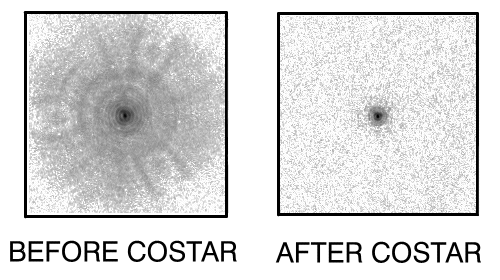
Even before the servicing mission that installed the corrective optics 2.5 years after the Hubble Space Telescope was put in orbit, astronomers were able to get significant results from the telescope. The images were computer-enhanced to correct for the spherical aberration to produce sharper images than from any ground-based telescope. Also, astronomers were able to observe ultraviolet light from celestial objects and fainter objects than could be seen from the ground. However, the computer processing took a long time and the aberration prevented the focussing of most of the light. This meant that astronomers could not see the very faint (and distant) objects they were looking for. Astronomers and the public were very pleased after the corrective optics were installed.
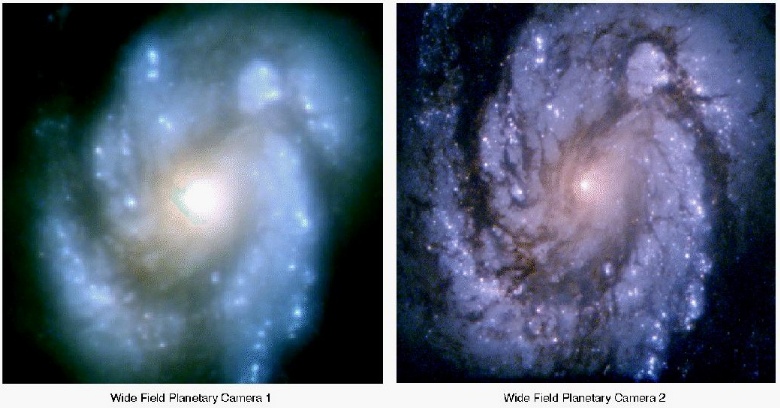
M 100 a few days before (left) and after (right) the corrective optics (COSTAR) were installed in December 1993.
Radio Telescopes
Radio astronomy has its roots back in the 1930's when Karl Jansky accidentally detected radio emission from the center of the Milky Way as part of his research on the interference on transatlantic phone lines. The British advanced radio antenna technology in their development of radar technology to fight the German warplanes in World War II. After the war, astronomers adapted the technology to detect radio waves coming from space.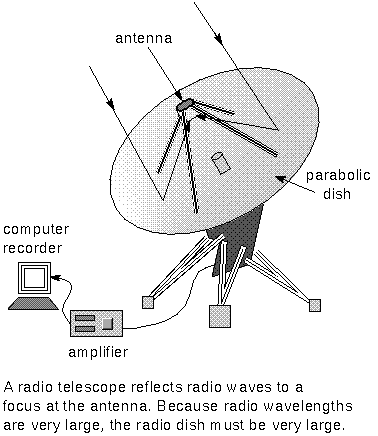
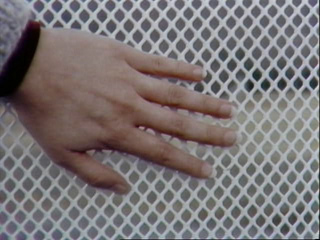 A radio telescope uses a large metal dish or wire mesh, usually parabolic-shaped,
to reflect the radio waves to an antenna above the dish. An example of a mesh is shown at
left. This was the mesh of the parabolic dish for the former 100-meter radio telescope at
Green Bank, West Virginia. Looking from underneath the radio
telescope, a person could see the clouds in the sky overhead but to the much longer
wavelength radio waves, the metal mesh was an excellent reflector.
A radio telescope uses a large metal dish or wire mesh, usually parabolic-shaped,
to reflect the radio waves to an antenna above the dish. An example of a mesh is shown at
left. This was the mesh of the parabolic dish for the former 100-meter radio telescope at
Green Bank, West Virginia. Looking from underneath the radio
telescope, a person could see the clouds in the sky overhead but to the much longer
wavelength radio waves, the metal mesh was an excellent reflector.
The signal from the antenna is sent to an amplifier to magnify the very faint signals. At the last step, the amplified signal is processed by a computer to turn the radio signals into an image that follows the shape of the radio emission. False colors are used to indicate the intensity of the radio emission at different locations. An example is shown below for Jupiter. Charged particles in its magnetic field produce a large amount of radio energy in donut-shaped regions around its center. A visible band image of Jupiter is shown below the radio image.
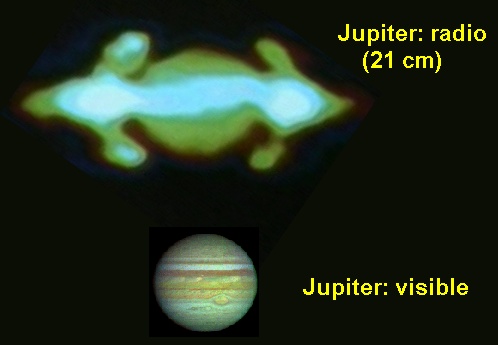
Radio telescopes are much larger than optical telescopes because radio wavelengths are much longer than optical wavelengths. The longer wavelengths means that the radio waves have lower energy than optical light waves. In order to collect enough radio photons to detect a signal, the radio dishes must be very large. Both optical and radio telescope reflectors use a parabolic shape to perfectly focus the light to a point. Increasing the size of the radio dish is also necessary in order to improve the clarity of the radio images. I will discuss the issue of image clarity further in the next two sections.
Radio telescopes detect the emission from cool clouds of hydrogen in the space between the stars. Hydrogen atoms are the most common type of atoms in the universe and much of the hydrogen gas is too far away from any star to produce emission in the optical wavelength band. Therefore, radio telescopes are a vital tool in understanding the universe. I will discuss further the use of radio waves to explore the material between the stars and the structure of our galaxy in the interstellar medium chapter.
Vocabulary
| chromatic aberration | objective | reflector |
|---|---|---|
| refractor | spherical aberration | telescope |
Review Questions
- What are the two basic types of telescopes? What are their advantages and disadvantages?
- Why are the large modern telescopes reflector telescopes?
- How is the rainbow of colors produced around the images in refractor telescopes?
- How will spherical aberration affect an image?
- How does the size and shape of a radio telescope compare to an optical telescope? Why is there such a difference in their sizes?
- What are the parts of a radio telescope?
- What kinds of things can be seen with a radio telescope that cannot be detected by an optical telescope?
![]() Go to
production of telescope powers section
Go to
production of telescope powers section
Go to Astronomy Notes beginning
Go to Astronomy 1 homepage
last updated 07 February 1999
Nick Strobel -- Email: strobel@lightspeed.net
(661) 395-4526
Bakersfield College
Physical Science Dept.
1801 Panorama Drive
Bakersfield, CA 93305-1219
